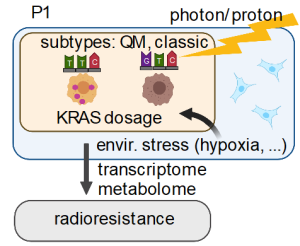GRK 2762 - Research Projects

Project P1Effect of KRAS gene dosage and molecular subtype on radiosensitivity in PDAC
Principal Investigators
Prof. Dr. med. Jens Siveke
Bridge Institute of Experimental Tumor Therapy
University Hospital Essen
Dr. rer. nat. Johann Matschke
Institute of Cell Biology (Tumor research)
University Hospital Essen
Prof. Dr. med. Beate Timmermann
Clinic for Particle Therapy
University Hospital Essen

Summary
The use of radiotherapy (RT) for treatment of pancreatic ductal adenocarcinoma (PDAC) is still controversially discussed. Herein, due to substantial technical advances the role of highly conformal RT, e.g. stereotactic RT (SBRT) and proton beam radiotherapy (PBT), in multimodal therapy of PDAC is increasing. Major challenges to successful therapy of PDAC are the lack of common targetable genetic alterations, the extensive molecular heterogeneity, and the pronounced therapeutic resistance, including RT resistance. Moreover, predictive biomarkers and therapeutic targets for therapy individualization are mostly missing. Recent studies including own preliminary work identified two molecular PDAC subtypes that differ substantially in gene expression profiles (e.g. KRAS gene dosage), metabolic and stromal phenotypes, sensitivity to chemotherapy or targeted therapies, and prognosis. However, the role of PDAC subtypes for RT resistance is still unknown. The proposed project aims to evaluate a panel of human PDAC cell lines representing the classical and QM subtype for their response to RT (photons, protons), to record dynamic changes in transcriptional and metabolic phenotypes upon RT, and to investigate how KRAS gene dosage, pharmacologic perturbation, or environmental stress alter the capacity of the PDAC cells to dynamically adapt their transcriptional and metabolic phenotypes in support of DSB repair and survival. Computational modeling of the obtained data shall allow to reveal subtype specific biomarkers and targets for modulating radiosensitivity.
Selected Publications
Heid I, Karakaya S, Münch C, Lueong SS, Winkelkotte AM, Liffers ST, Godfrey L, Cheung PF, Savvatakis K, Topping GJ, Englert F, Kritzner L, Grashei M, Kunzke T, Sun N, Walch A, Tannapfel A, Viebahn R, Wolters H, Uhl W, Vangala D, Smeets EMM, Aarntzen EHJG, Rauh D, Hoheisel JD, Hellerschmied D, Hahn SA, Schilling F, Braren R, Trajkovic-Arsic M, Siveke JT. Functional metabolic phenotyping of human pancreatic ductal adenocarcinoma. bioRxiv. 2021:2021.2007.2023.452145.
Cheung PF, Yang J, Krengel K, Althoff K, Yip CW, Siu EH, Ng LW, Lang KS, Cham L, Engel DR, Soun C, Cima I, Scheffler B, Striefler JK, Sinn M, Bahra M, Pelzer U, Oettle H, Markus P, Smeets EM, Aarntzen EH, Savvatakis K, Liffers S-T, Neander C, Bazarna A, Zhang X, Merkler D, Paschen A, Crawford HC, Chan AW, Cheung ST, Siveke JT. Progranulin promotes immune evasion of pancreatic adenocarcinoma through regulation of MHCI expression. Nat Commun. 2022 Jan 10;13(1):156.
Cheung PF, Neff F, Neander C, Bazarna A, Savvatakis K, Liffers ST, Althoff K, Lee CL, Moding EJ, Kirsch DG, Saur D, Bazhin AV, Trajkovic-Arsic M, Heikenwalder MF, Siveke JT. Notch-Induced Myeloid Reprogramming in Spontaneous Pancreatic Ductal Adenocarcinoma by Dual Genetic Targeting. Cancer Res. 2018;78(17):4997-5010.
Sun N, Trajkovic-Arsic M, Li F, Wu Y, Munch C, Kunzke T, Feuchtinger A, Steiger K, Schlitter AM, Weichert W, Esposito I, Siveke JT, Walch A. Native glycan fragments detected by MALDI mass spectrometry imaging are independent prognostic factors in pancreatic ductal adenocarcinoma. EJNMMI Res. 2021;11(1):120.
Matschke J, Riffkin H, Klein D, Handrick R, Lüdemann L, Metzen E, Shlomi T, Stuschke M, Jendrossek V. Targeted Inhibition of Glutamine-Dependent Glutathione Metabolism Overcomes Death Resistance Induced by Chronic Cycling Hypoxia. Antioxid Redox Signal. 2016;25(2):89-10721.
Krysztofiak A, Szymonowicz K, Hlouschek J, Xiang K, Waterkamp C, Larafa S, Goetting I, Vega-Rubin-de-Celis S, Theiss C, Matschke V, Hoffmann D, Jendrossek V, Matschke J. Metabolism of cancer cells commonly responds to irradiation by a transient early mitochondrial shutdown. iScience. 2021;24(11):103366.
Hlouschek J, Ritter V, Wirsdorfer F, Klein D, Jendrossek V, Matschke J. Targeting SLC25A10 alleviates improved antioxidant capacity and associated radioresistance of cancer cells induced by chronic-cycling hypoxia. Cancer Lett. 2018;439:24-38.
Szymonowicz K, Krysztofiak A, Linden JV, Kern A, Deycmar S, Oeck S, Squire A, Koska B Hlouschek J, Vüllings M, Neander C, Siveke JT, Matschke J, Pruschy, Timmermann B, Jendrossek V.. Proton Irradiation Increases the Necessity for Homologous Recombination Repair Along with the Indispensability of Non-Homologous End Joining. Cells. 2020;9(4):889.
Behrends C, Haussmann J, Kramer PH, Langendijk JA, Gottschlag H, Geismar D, Budach W, Timmermann B. Model-based comparison of organ at risk protection between VMAT and robustly optimised IMPT plans. Z Med Phys. 2021;31(1):5-15.
Bäumer C, Ackermann B, Hillbrand M, Kaiser FJ, Koska B, Latzel H, Lühr A, Menkel S, Timmermann B. Dosimetry intercomparison of four proton therapy institutions in Germany employing spot scanning. Z Med Phys. 2017;27(2):80-85.
Dutz A, Lühr A, Agolli L, Troost EGC, Krause M, Baumann M, Vermeren X, Geismar D, Schapira EF, Bussière M, Daly JE, Bussière MR Timmermann B, Shih HA, Löck S. Development and validation of NTCP models for acute side-effects resulting from proton beam therapy of brain tumours. Radiother Oncol. 2019;130:164-171.
Pfeiler T, Ahmad Khalil D, Ayadi M, Bäumer C, Blanck O, Chan M, Engwall E, Geismar D, Peters S, Plaude S, Spaan B, Timmermann B, Wulff J. Motion effects in proton treatments of hepatocellular carcinoma-4D robustly optimised pencil beam scanning plans versus double scattering plans. Phys Med Biol. 2018;63(23):235006.
Behrends C, Bäumer C, Verbeek N, Ehlert J, Prasad R, Wulff J, Lühr A, Timmermann B. Technical note: Providing proton fields down to the few-MeV level at clinical pencil beam scanning facilities for radiobiological experiments. Med Phys. 2022 Jan;49(1):666-674.

